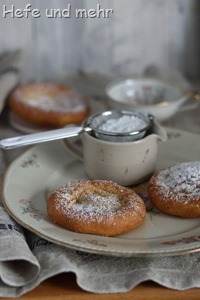 The Ausgezogne is a south german deep fried cake which is similar to a doughnut but instead of a hole there is a very thin dough layer in the middle. Sometime this cake is called Knieküchlein (literally knee cake), too as the thin dough layer can be archived by stretching the dough over the knee. But it can be stretched by hand, too, and is very similar to forming pizza dough.
The Ausgezogne is a south german deep fried cake which is similar to a doughnut but instead of a hole there is a very thin dough layer in the middle. Sometime this cake is called Knieküchlein (literally knee cake), too as the thin dough layer can be archived by stretching the dough over the knee. But it can be stretched by hand, too, and is very similar to forming pizza dough.
To get a good stretchable dough it is important to develop the gluten network fully. To support the gluten development a pâte fermentée is added to the rather soft dough. This makes it easy to form the Ausgezogne dircetly before frying. The thin part gets crisp while the outer rim is soft and fluffy. And this contrast is typical for the little cake and makes it so delicious!

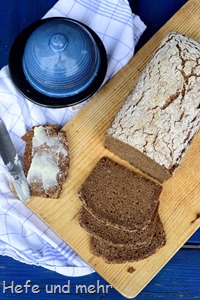 The grandmother of my dearest complained that today you can not get real blackbread anymore. The “modern” one is to moist in her opinion. When I asked how a “real” blackbread should be, she answered: “Just like it once had been”. My argument that I do not know how the bread looked like ninety years back in the past just gained me a critical gaze. But at the end I could get some informations about her childhoods blackbread from her: moist, but not so moist we today, dark and baked with rather fine cracked rye. And my ambitions was aroused to recreate this bread for her.
The grandmother of my dearest complained that today you can not get real blackbread anymore. The “modern” one is to moist in her opinion. When I asked how a “real” blackbread should be, she answered: “Just like it once had been”. My argument that I do not know how the bread looked like ninety years back in the past just gained me a critical gaze. But at the end I could get some informations about her childhoods blackbread from her: moist, but not so moist we today, dark and baked with rather fine cracked rye. And my ambitions was aroused to recreate this bread for her.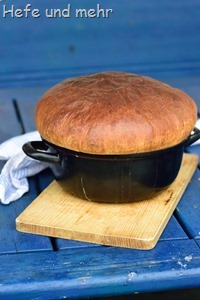 A small part of a comment caught my attention: the word “Pottweck”. I asked for a description and got a very detailed explanation from Jürgen.
A small part of a comment caught my attention: the word “Pottweck”. I asked for a description and got a very detailed explanation from Jürgen. 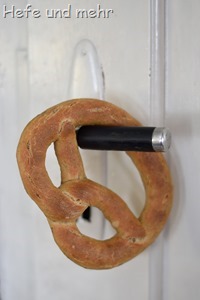 When I was researching another recipe, I stumbled upon the recipe for anise pretzels . These pretzles are made without lye and are typically served during winter in the region Upper Franconia. They contain a lot of anise, as their name promise.
When I was researching another recipe, I stumbled upon the recipe for anise pretzels . These pretzles are made without lye and are typically served during winter in the region Upper Franconia. They contain a lot of anise, as their name promise.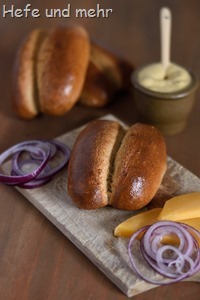

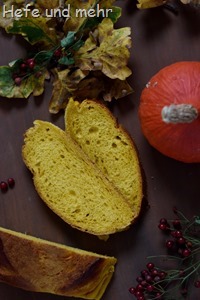 In this year Indian summer lasted long. But now the days are getting shorter and air is chilly when I leave the house in the morning. And when I drive through the range of the hills I can see the first sun rays turning the misty valleys below into golden lakes. It is autumn, finally.
In this year Indian summer lasted long. But now the days are getting shorter and air is chilly when I leave the house in the morning. And when I drive through the range of the hills I can see the first sun rays turning the misty valleys below into golden lakes. It is autumn, finally.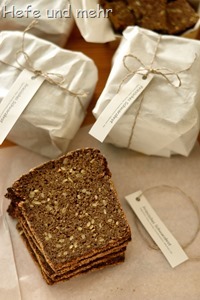 The very first suggestion I got for the post series “regional bread” was East Frisian Black Bread. As I already wrote a recipe for the magazine “
The very first suggestion I got for the post series “regional bread” was East Frisian Black Bread. As I already wrote a recipe for the magazine “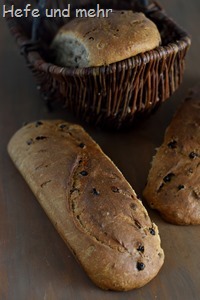 I’m totally thrilled about all the little jewels I meet in range of my “regional bread” series. From
I’m totally thrilled about all the little jewels I meet in range of my “regional bread” series. From 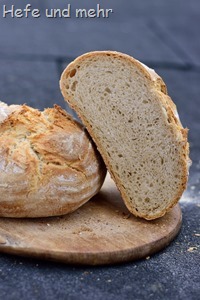 The second bread for my regional bread collection is one I know well: a crusty bread from the rhineland, called “Rheinisches Krustenbrot”.
The second bread for my regional bread collection is one I know well: a crusty bread from the rhineland, called “Rheinisches Krustenbrot”.